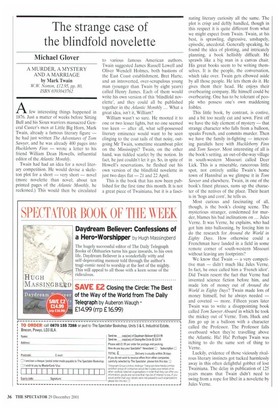The strange case of the blindfold novelette
Michael Glover
A MURDER, A MYSTERY AND A MARRIAGE by Mark Twain W. W. Norton, £12.95, pp. 80. ISBN 0393043762 Afew interesting things happened in 1876. Just a matter of weeks before Sitting Bull and his Sioux warriors massacred General Custer's men at Little Big Horn, Mark Twain, already a famous literary figure — he had just written The Adventures of Tom Sawyer, and he was already 400 pages into Hucklebeny Finn — wrote a letter to his friend William Dean Howells, influential editor of the Atlantic Monthly.
Twain had had an idea for a novel literary competition. He would devise a skeleton plot for a short — very short — novel (more novelette than novel; about ten printed pages of the Atlantic Monthly, he reckoned.) This would then be circulated to various famous American authors. Twain suggested James Russell Lowell and Oliver Wendell Holmes, both bastions of the East Coast establishment, Bret Harte. and an introverted, over-scrupulous young man (younger than Twain by eight years) called Henry James. Each of them would write his own version of this 'blindfold novelette', and they could all be published together in the Atlantic Monthly ... What a great idea, isn't it, William?
William wasn't so sure. He mooted it to one or two lesser lights, but no one seemed too keen — after all, what self-possessed literary eminence would want to be seen clinging to the coat tails of that noisy, outgoing Mr Twain, sometime steamboat pilot on the Mississippi? Twain, on the other hand, was tickled scarlet by the notion. In fact, he just couldn't let it go. So, in spite of Howell's reservations, he fleshed out his own version of the blindfold novelette in just two days flat — 21 and 22 April.
This is the book that has now been published for the first time this month. It is not a great piece of Twainiana, but it is a fasci nating literary curiosity all the same. The plot is crisp and deftly handled, though in this respect it is quite different from what we might expect from Twain. Twain, at his best, is sprawling, digressive, unshapely, episodic, anecdotal. Generally speaking, he found the idea of plotting, and intricately planning, a book hellishly difficult. He sprawls like a big man in a canvas chair. His great books seem to be writing themselves. It is the people, the conversation, which take over. Twain gets elbowed aside by all those people. He lets them do it. He gives them their head. He enjoys their overbearing company. He himself could be overbearing. One has to be tolerant of people who possess one's own maddening foibles.
This little book, by contrast, is costive, and a bit too neatly cut and sewn. First off we have the tidy element of mystery — that strange character who falls from a balloon, speaks French, and commits murder. Then we have the family in-fighting — interesting parallels here with Huckleberry Finn and Tom Sawyer. Most interesting of all is the book's setting, an out-of-the-way village in south-western Missouri called Deer Lick. This is a miserable, rancorous little spot, not entirely unlike Twain's home town of Hannibal as we glimpse it in Tom Sawyer and elsewhere. Twain, in one of the book's finest phrases, sums up the character of the natives of the place. Their heart is in 'hogs and corn', he tells us.
Most curious and fascinating of all, though, is the book's closing scene. The mysterious stranger, condemned for murder, blames his bad inclinations on ... Jules Verne. It was Verne, he explains, who had got him into ballooning, by forcing him to do the research for Around the World in Eighty Days. How otherwise could a Frenchman have landed in a field in some remote corner of south-western Missouri without leaving any footprints?
We know that Twain — a very competitive man — didn't much like Jules Verne. In fact, he once called him a 'French idiot'. Did Twain resent the fact that Verne had invented science fiction before him, and made lots of money out of Around the World in Eighty Days? Twain made lots of money himself, but he always needed — and coveted — more. Fifteen years later Twain was to write a disappointing book called Tom Sawyer Aboard in which he took the mickey out of Verne. Tom, Huck and Jim go up in a balloon with a character called the Professor. The Professor falls overboard when they're travelling above the Atlantic. Ha! Ha! Perhaps Twain was itching to do the same sort of thing to Verne.
Luckily, evidence of those viciously rivalrous literary instincts got tucked harmlessly away in this often delightful gobbet of lost Twainiana. The delay in publication of 125 years means that Twain didn't need to swing from a rope for libel in a novelette by Jules Verne.


























































 Previous page
Previous page